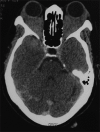Sclerosing Lesions of the Orbit: A Review
- PMID: 26692715
- PMCID: PMC4660530
- DOI: 10.4103/0974-9233.167807
Sclerosing Lesions of the Orbit: A Review
Abstract
Orbital sclerosing inflammation is a distinct group of pathologies characterized by indolent growth with minimal or no signs of inflammation. However, contrary to earlier classifications, it should not be considered a chronic stage of acute inflammation. Although rare, orbital IgG4-related disease has been associated with systemic sclerosing pseudotumor-like lesions. Possible mechanisms include autoimmune and IgG4 related defective clonal proliferation. Currently, there is no specific treatment protocol for IgG4-related disease although the response to low dose steroid provides a good response as compared to non-IgG4 sclerosing pseudotumor. Specific sclerosing inflammations (e.g. Wegener's disease, sarcoidosis, Sjogren's syndrome) and neoplasms (lymphoma, metastatic breast carcinoma) should be ruled out before considering idiopathic sclerosing inflammation as a diagnosis.
Keywords: IgG4; Inflammation; Neoplasm; Orbit; Sclerosing.
Figures
Similar articles
-
IgG4-related disease in idiopathic sclerosing orbital inflammation.Br J Ophthalmol. 2015 Nov;99(11):1493-7. doi: 10.1136/bjophthalmol-2014-305528. Epub 2015 May 6. Br J Ophthalmol. 2015. PMID: 25947555
-
Idiopathic orbital inflammation: a new dimension with the discovery of immunoglobulin G4-related disease.Curr Opin Ophthalmol. 2012 Sep;23(5):415-9. doi: 10.1097/ICU.0b013e32835563ec. Curr Opin Ophthalmol. 2012. PMID: 22729180 Review.
-
Ophthalmic manifestations of IgG4-related disease: single-center experience and literature review.Semin Arthritis Rheum. 2014 Jun;43(6):806-17. doi: 10.1016/j.semarthrit.2013.11.008. Epub 2013 Nov 15. Semin Arthritis Rheum. 2014. PMID: 24513111 Review.
-
Infliximab for IgG4-Related Orbital Disease.Ophthalmic Plast Reconstr Surg. 2017 May/Jun;33(3S Suppl 1):S162-S165. doi: 10.1097/IOP.0000000000000625. Ophthalmic Plast Reconstr Surg. 2017. PMID: 26784550
-
IgG4-related Ophthalmic Disease in Idiopathic Sclerosing and Non-Sclerosing Orbital Inflammation: A 25-Year Experience.Curr Eye Res. 2019 Nov;44(11):1220-1225. doi: 10.1080/02713683.2019.1627462. Epub 2019 Jun 13. Curr Eye Res. 2019. PMID: 31154852
Cited by
-
Idiopathic Orbital Inflammation: Review of Literature and New Advances.Middle East Afr J Ophthalmol. 2018 Apr-Jun;25(2):71-80. doi: 10.4103/meajo.MEAJO_44_18. Middle East Afr J Ophthalmol. 2018. PMID: 30122852 Free PMC article. Review.
-
Rare Diseases of the Orbit.Laryngorhinootologie. 2021 Apr;100(S 01):S1-S79. doi: 10.1055/a-1384-4641. Epub 2021 Apr 30. Laryngorhinootologie. 2021. PMID: 34352903 Free PMC article. Review.
-
CT and MR imaging of orbital inflammation.Neuroradiology. 2018 Dec;60(12):1253-1266. doi: 10.1007/s00234-018-2103-4. Epub 2018 Oct 11. Neuroradiology. 2018. PMID: 30310941 Free PMC article. Review.
-
IgG4-Related Orbitopathy.Middle East Afr J Ophthalmol. 2015 Oct-Dec;22(4):405-6. doi: 10.4103/0974-9233.167816. Middle East Afr J Ophthalmol. 2015. PMID: 26692707 Free PMC article. No abstract available.
-
Case of IgG4 orbitopathy's remarkable response to oral corticosteroid therapy.BMJ Case Rep. 2020 Aug 26;13(8):e236442. doi: 10.1136/bcr-2020-236442. BMJ Case Rep. 2020. PMID: 32847889 Free PMC article. No abstract available.
References
-
- Rootman J. 2nd ed. Vol. 156. USA: Lippincott Williams and Wilkins; 2003. Diseases of the Orbit: A Multidisciplinary Approach; pp. 455–506.
-
- Thorne JE, Volpe NJ, Wulc AE, Galetta SL. Caught by a masquerade: Sclerosing orbital inflammation. Surv Ophthalmol. 2002;47:50–4. - PubMed
-
- Liu CH, Ma L, Ku WJ, Kao LY, Tsai YJ. Bilateral idiopathic sclerosing inflammation of the orbit: Report of three cases. Chang Gung Med J. 2004;27:758–65. - PubMed
-
- Abramovitz JN, Kasdon DL, Sutula F, Post KD, Chong FK. Sclerosing orbital pseudotumor. Neurosurgery. 1983;12:463–8. - PubMed
-
- Gordon LK. Orbital inflammatory disease: A diagnostic and therapeutic challenge. Eye (Lond) 2006;20:1196–206. - PubMed
Publication types
MeSH terms
Substances
LinkOut - more resources
Full Text Sources
Other Literature Sources
Medical
Molecular Biology Databases



